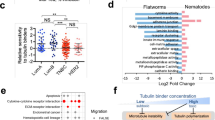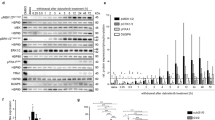Abstract
Extent of resection of glioblastoma (GBM) correlates with overall survival. Fluorescence-guided resection (FGR) using 5-aminolevulinic acid (5-ALA) can improve the extent of resection. Unfortunately not all patients given 5-ALA accumulate sufficient quantities of protoporphyrin IX (PpIX) for successful FGR. In this study, we investigated the effects of dexamethasone, desipramine, phenytoin, valproic acid, and levetiracetam on the production and accumulation of PpIX in U87MG cells. All of these drugs, except levetiracetam, reduce the total amount of PpIX produced by GBM cells (p < 0.05). When dexamethasone is mixed with another drug (desipramine, phenytoin, valproic acid or levetiracetam) the amount of PpIX produced is further decreased (p < 0.01). However, when cells are analyzed for PpIX cellular retention, dexamethasone accumulated significantly more PpIX than the vehicle control (p < 0.05). Cellular retention of PpIX was not different from controls in cells treated with dexamethasone plus desipramine, valproic acid or levetiracetam, but was significantly less for dexamethasone plus phenytoin (p < 0.01). These data suggest that medications given before and during surgery may interfere with PpIX accumulation in malignant cells. At this time, levetiracetam appears to be the best medication in its class (anticonvulsants) for patients undergoing 5-ALA-mediated FGR.



Similar content being viewed by others
References
Ostrom QT, Gittleman H, Liao P, Rouse C, Chen Y, Dowling J, Wolinsky Y, Kruchko C, Barnholtz-Sloan J (2014) CBTRUS statistical report: primary brain and central nervous system tumors diagnosed in the united states in 2007–2011. Neuro-oncology 16(Suppl 4):iv1–iv63. doi:10.1093/neuonc/nou223
Almeida JP, Chaichana KL, Rincon-Torroella J, Quinones-Hinojosa A (2015) The value of extent of resection of glioblastomas: clinical evidence and current approach. Curr Neurol Neurosci Rep 15:517. doi:10.1007/s11910-014-0517-x
Schiffmann E, Shemin D (1957) Further studies on the utilization of delta-aminolevulinic acid for porphyrin synthesis. J Biol Chem 225:623–628
Stummer W, Stocker S, Wagner S, Stepp H, Fritsch C, Goetz C, Goetz AE, Kiefmann R, Reulen HJ (1998) Intraoperative detection of malignant gliomas by 5-aminolevulinic acid-induced porphyrin fluorescence. Neurosurgery 42:518–525 (discussion 525–516)
Stummer W, Pichlmeier U, Meinel T, Wiestler OD, Zanella F, Reulen HJ, Group AL-GS (2006) Fluorescence-guided surgery with 5-aminolevulinic acid for resection of malignant glioma: a randomised controlled multicentre phase III trial. Lancet Oncol 7:392–401. doi:10.1016/S1470-2045(06)70665-9
Diez Valle R, Tejada Solis S, Idoate Gastearena MA, Garcia de Eulate R, Dominguez Echavarri P, Aristu Mendiroz J (2011) Surgery guided by 5-aminolevulinic fluorescence in glioblastoma: volumetric analysis of extent of resection in single-center experience. J Neurooncol 102:105–113. doi:10.1007/s11060-010-0296-4
Della Puppa A, De Pellegrin S, d’Avella E, Gioffre G, Rossetto M, Gerardi A, Lombardi G, Manara R, Munari M, Saladini M, Scienza R (2013) 5-aminolevulinic acid (5-ALA) fluorescence guided surgery of high-grade gliomas in eloquent areas assisted by functional mapping. Our experience and review of the literature. Acta Neurochir 155:965–972. doi:10.1007/s00701-013-1660-x (discussion 972)
Schucht P, Beck J, Abu-Isa J, Andereggen L, Murek M, Seidel K, Stieglitz L, Raabe A (2012) Gross total resection rates in contemporary glioblastoma surgery: results of an institutional protocol combining 5-aminolevulinic acid intraoperative fluorescence imaging and brain mapping. Neurosurgery 71:927–935. doi:10.1227/NEU.0b013e31826d1e6b (discussion 935–926)
Schucht P, Knittel S, Slotboom J, Seidel K, Murek M, Jilch A, Raabe A, Beck J (2014) 5-ALA complete resections go beyond MR contrast enhancement: shift corrected volumetric analysis of the extent of resection in surgery for glioblastoma. Acta Neurochir 156:305–312. doi:10.1007/s00701-013-1906-7 (discussion 312)
von Campe G, Moschopulos M, Hefti M (2012) 5-Aminolevulinic acid-induced protoporphyrin IX fluorescence as immediate intraoperative indicator to improve the safety of malignant or high-grade brain tumor diagnosis in frameless stereotactic biopsies. Acta Neurochir (Wien) 154:585–588
Utsuki S, Oka H, Kijima C, Inukai M, Fujii K, Ishizuka M, Takahashi K, Inoue K (2012) Preoperative prediction of whether intraoperative fluorescence of protoporphyrin IX can be achieved by 5-aminolevulinic acid administration. Int J Clin Med 3:132
Tamura A, Onishi Y, An R, Koshiba S, Wakabayashi K, Hoshijima K, Priebe W, Yoshida T, Kometani S, Matsubara T, Mikuriya K, Ishikawa T (2007) In vitro evaluation of photosensitivity risk related to genetic polymorphisms of human ABC transporter ABCG2 and inhibition by drugs. Drug Metab Pharmacokinet 22:428–440
Jin Y, Bin ZQ, Qiang H, Liang C, Hua C, Jun D, Dong WA, Qing L (2009) ABCG2 is related with the grade of glioma and resistance to mitoxantone, a chemotherapeutic drug for glioma. J Cancer Res Clin Oncol 135:1369–1376
Teng L, Nakada M, Zhao SG, Endo Y, Furuyama N, Nambu E, Pyko IV, Hayashi Y, Hamada JI (2011) Silencing of ferrochelatase enhances 5-aminolevulinic acid-based fluorescence and photodynamic therapy efficacy. Br J Cancer 104:798–807. doi:10.1038/bjc.2011.12
Hefti M, Albert I, Luginbuehl V (2012) Phenytoin reduces 5-aminolevulinic acid-induced protoporphyrin IX accumulation in malignant glioma cells. J Neurooncol 108:443–450. doi:10.1007/s11060-012-0857-9
Lawrence JE, Patel AS, Rovin RA, Belton RJ Jr, Bammert CE, Steele CJ, Winn RJ (2014) Quantification of protoporphyrin IX accumulation in glioblastoma cells: a new technique. ISRN Surg 2014:405360. doi:10.1155/2014/405360
Hochhaus G, Barth J, al-Fayoumi S, Suarez S, Derendorf H, Hochhaus R, Mollmann H (2001) Pharmacokinetics and pharmacodynamics of dexamethasone sodium-m-sulfobenzoate (DS) after intravenous and intramuscular administration: a comparison with dexamethasone phosphate (DP). J Clin Pharmacol 41:425–434
Lancelin F, Franchon E, Kraoul L, Garciau I, Brovedani S, Tabaouti K, Landre E, Chassoux F, Paubel P, Piketty ML (2007) Therapeutic drug monitoring of levetiracetam by high-performance liquid chromatography with photodiode array ultraviolet detection: preliminary observations on correlation between plasma concentration and clinical response in patients with refractory epilepsy. Ther Drug Monit 29:576–583. doi:10.1097/FTD.0b013e318157032d
Schatlo B, Fandino J, Smoll NR, Wetzel O, Remonda L, Marbacher S, Perrig W, Landolt H, Fathi A-R (2015) Outcomes after combined use of intraoperative MRI and 5-aminolevulinic acid in high-grade glioma surgery. Neuro-oncology 12:1560–1567. doi:10.1093/neuonc/nov049
Awad AJ, Sloan A (2014) The use of 5-ALA in glioblastoma resection: two cases with long-term progression-free survival. Cureus. doi:10.7759/cureus.202
Roder C, Bisdas S, Ebner FH, Honegger J, Naegele T, Ernemann U, Tatagiba M (2014) Maximizing the extent of resection and survival benefit of patients in glioblastoma surgery: high-field iMRI versus conventional and 5-ALA-assisted surgery. Eur J Surg Oncol 40:297–304. doi:10.1016/j.ejso.2013.11.022
Veiseh M, Gabikian P, Bahrami SB, Veiseh O, Zhang M, Hackman RC, Ravanpay AC, Stroud MR, Kusuma Y, Hansen SJ, Kwok D, Munoz NM, Sze RW, Grady WM, Greenberg NM, Ellenbogen RG, Olson JM (2007) Tumor paint: a chlorotoxin:Cy5.5 bioconjugate for intraoperative visualization of cancer foci. Cancer Res 67:6882–6888. doi:10.1158/0008-5472.CAN-06-3948
Koc K, Anik I, Cabuk B, Ceylan S (2008) Fluorescein sodium-guided surgery in glioblastoma multiforme: a prospective evaluation. Br J Neurosurg 22:99–103. doi:10.1080/02688690701765524
Schucht P, Beck J, Raabe A (2015) Response to: “Maximizing the extent of resection and survival benefit of patients in glioblastoma surgery: high-field iMRI versus conventional and 5-ALA-assisted surgery”. Eur J Surg Oncol 41:604–605. doi:10.1016/j.ejso.2014.07.044
Schwake M, Stummer W, Suero Molina EJ, Wolfer J (2015) Simultaneous fluorescein sodium and 5-ALA in fluorescence-guided glioma surgery. Acta Neurochir (Wien) 157:877–879. doi:10.1007/s00701-015-2401-0
Yamada S, Muragaki Y, Maruyama T, Komori T, Okada Y (2015) Role of neurochemical navigation with 5-aminolevulinic acid during intraoperative MRI-guided resection of intracranial malignant gliomas. Clin Neurol Neurosurg 130:134–139. doi:10.1016/j.clineuro.2015.01.005
Stummer W, Beck T, Beyer W, Mehrkens JH, Obermeier A, Etminan N, Stepp H, Tonn JC, Baumgartner R, Herms J, Kreth FW (2008) Long-sustaining response in a patient with non-resectable, distant recurrence of glioblastoma multiforme treated by interstitial photodynamic therapy using 5-ALA: case report. J Neurooncol 87:103–109. doi:10.1007/s11060-007-9497-x
Peng Q, Warloe T, Berg K, Moan J, Kongshaug M, Giercksky KE, Nesland JM (1997) 5-Aminolevulinic acid-based photodynamic therapy. Clinical research and future challenges. Cancer 79:2282–2308
Kim JE, Cho HR, Xu WJ, Kim JY, Kim SK, Kim SK, Park SH, Kim H, Lee SH, Choi SH, Park S, Park CK (2015) Mechanism for enhanced 5-aminolevulinic acid fluorescence in isocitrate dehydrogenase 1 mutant malignant gliomas. Oncotarget
Author information
Authors and Affiliations
Corresponding author
Rights and permissions
About this article
Cite this article
Lawrence, J.E., Steele, C.J., Rovin, R.A. et al. Dexamethasone alone and in combination with desipramine, phenytoin, valproic acid or levetiracetam interferes with 5-ALA-mediated PpIX production and cellular retention in glioblastoma cells. J Neurooncol 127, 15–21 (2016). https://doi.org/10.1007/s11060-015-2012-x
Received:
Accepted:
Published:
Issue Date:
DOI: https://doi.org/10.1007/s11060-015-2012-x




